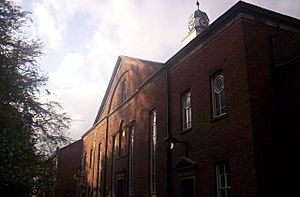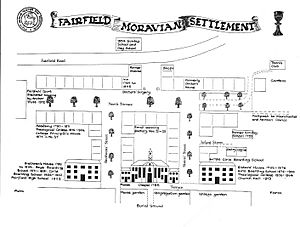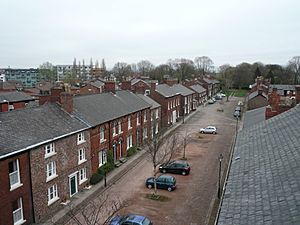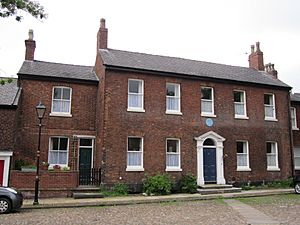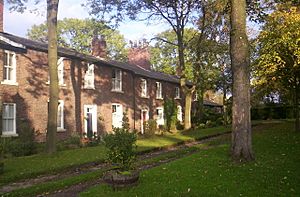Fairfield Moravian Church facts for kids
Fairfield Moravian Church is a special church and village in Droylsden, England. It was started in 1785 by Benjamin La Trobe. The church was built as a center for the Moravian Church to share its message in the Manchester area. Some of the old buildings in Fairfield Square are now protected as important historical sites.
History of Fairfield Moravian Settlement
How the Village Began
In 1742, the Moravians, a Christian group, set up a main base in northern England. They wanted to spread their message. Later, they started a church in Dukinfield, Cheshire, in 1751. They also built a small village there in 1755. But they needed more space to grow.
So, in 1783, the Moravians bought 60 acres of land in Droylsden. This land became the Fairfield Moravian Settlement. A Moravian member named Brother John Lees designed the new village. He might have even sold his own coal mines to help pay for it! Other Moravian churches in England, Germany, and America also helped. The whole project cost about £6,000.
Building the Church and Homes
On June 9, 1784, they laid the first stones for the church and other buildings. They put a special message inside the church's stone. It said they wanted to live apart from worldly things. They also wanted to be close to God and share His message. They believed strongly in the Bible and the Augsburg Confession. This confession was a set of beliefs that influenced the Moravians.
By May 1785, the main buildings and 13 homes were ready. In Moravian settlements back then, people lived in groups. There were groups for married people, single men, and single women. Single men and women lived in shared houses. They also worked together within the village.
Opening the Church
The church had a private opening on July 15, 1785. Then, on Sunday, July 17, it opened to the public. About 1,500 people came to the morning service! It started with music played on the new organ. Brass bands from other Moravian villages also played. Using brass instruments in church was a special Moravian tradition. Benjamin La Trobe gave a long sermon that day.
Benjamin La Trobe was the leader of the Moravian Church in the United Kingdom. His son, Benjamin Henry Latrobe, later became a famous architect. He designed the Capitol building in Washington, D.C., in the United States.
Life in the Settlement
In 1785, Fairfield had 110 members. This included 22 men living in the single men's house. There were also 45 women in the single women's house. A group of elders, including the minister, looked after the church members. They also had overseers who managed the village. These overseers took care of buildings, roads, and streetlights.
People in the village had different jobs. The single men did weaving, baking, and saddlery. There was also an inn, which closed in 1848 due to problems with behavior. It reopened later as a hostel. The single women worked on a farm, in a laundry, and a needlework shop. The village even had its own fire engine! Later, people also made bricks and worked with cotton.
The single men's house sometimes had problems with money. The young men were often told off for drinking too much at the inn. Once, they even sprayed a fire hose on someone during a drill!
The church building was called the "hall" back then. It had no lights or heating. People sat on hard benches. The women sat on one side, and the men on the other. This continued until the late 1800s. There was also a gallery with an organ for the choir.
Making Decisions with the Lot
The Fairfield church sometimes used something called "the Lot" to make important decisions. This was like drawing straws. After praying, they would ask a question. Then, they would pick one of three slips of paper. One said 'Yes', one said 'No', and one was blank. This practice was based on old Bible stories. It showed their belief that Christ guided their church.
By 1815, they started using the Lot less for deciding who could join the church. For example, in 1815, a woman named Hannah Kenyon wanted to join the church. The elders and members agreed she was sincere. But when they used the Lot, it said 'no'.
Records show that some marriages were arranged by the elders and confirmed by the Lot. If someone married outside the church, they were asked to leave. By 1820, using the Lot to choose marriage partners also became less common. However, it was still used to choose ministers. As late as 1822, a woman from Fairfield was chosen by Lot to marry a minister serving in Jamaica. She accepted and sailed there.
God's Acre: The Burial Ground
The church had a special burial ground called 'God's Acre'. It was in front of the church, surrounded by hedges. All the gravestones were small and flat. They only showed the person's name and age. This showed that everyone was equal in death. At first, men and women were buried in separate areas. A sundial in the graveyard had a motto: 'I die today, I live tomorrow'.
Mourning was not encouraged. When someone died, a brass band and the minister led the body to the grave. On Easter Sunday, the church members still gather in God's Acre. They celebrate the idea of new life and hope.
Schools in Fairfield
Fairfield had schools for children. A boarding school for girls opened in 1796. A boys' school opened in 1802. The boys' school closed in 1891, and the girls' school closed in 1919. The girls' school building later became Fairfield High School.
Sharing the Message
The Moravian Church wanted to share its Christian message with others. They did not try to take members from other churches. Instead, they wanted to help people grow in their faith. They also wanted to share the Gospel with people in faraway lands.
Fairfield supported missionary work overseas. Many brothers and sisters from Fairfield served as missionaries. They went to places like Labrador, Jamaica, India, and Tanzania.
People from Fairfield also helped start new churches nearby. In 1822, a group started in Oldham, which became Salem Moravian Church in 1825. They also tried to start a group in Glossop, but it did not last.
In the 1840s, the church supported "scripture readers." These people visited homes in Manchester. They used the Bible to teach people to read and write. This work led to new churches being built in Droylsden and Oldham. Only Westwood Moravian Church in Oldham became a permanent church. The Fairfield people gave a lot of money to help Westwood.
In 1899, another new church opened in Wheler Street. It was an iron building and cost £215 to build.
Changes Over Time
By the 1860s, life in the Fairfield settlement had changed. Fewer people living in the village were part of the church. The church became more open to people from a wider area. Things that were once seen as wrong, like plays, became accepted. The social life of Fairfield became more like other churches. They had a drama club, a music choir, and a young men's club for games and smoking by the 1880s.
Theological College
The Moravian Theological College, which trained ministers, moved to Fairfield in 1875. It closed in 1958. The building was later fixed up and became a Sunday school and community center. It reopened in 1983.
Ministers of Fairfield Moravian Church
Fairfield Moravian Church has had many ministers over its long history. The first minister was John Worthington, who served from 1785 to 1786. Since then, many dedicated people have led the congregation, with Peter Madsen Gubi serving as the minister from 2023.
See also
- Listed buildings in Droylsden


